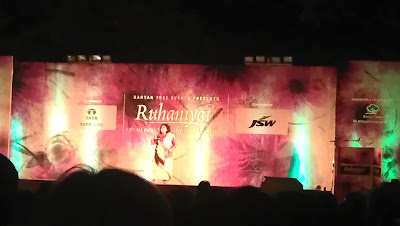Before the start of 5th Bangalore International Film Fetival, I jokingly remarked to my friend "I would be more happy than sad if i miss any film at the festival on account of it being house full". I was confident that most of the seats would go empty as who watches these odd, hard hitting, heavy, no-song films and that too with subtitles in this "Dabbang" age other than a few eccentric people. I could not have been more wrong.
The lineup of films at 5th edition of BIFFES was strong, diverse and offered something of everything. I was happy that they chose to include a retrospective of Fatih Akin, whom i have followed after accidentally watching his Gegen die wand. Also included in the festival were newly released films by famous directors like Amour by Michael Haneke and Pieta by Kim ki Duk. Typically, there are retrospectives, films from a given director or an actor as a focus area, but Biffes also included a section wherein they focussed on films from a country, Denmark, Taiwan and Germany in this edition. A country focus is a great idea as it presents a unique opportunity to see a country from different perspectives.
By skipping a party, i was able to catch the Oscar nominated Monsieur Lazhar by Philippe Falardeau. A film deserving of an oscar nomination, it has everything that one can hope for, yet it fails to hit the strectch goal that the winner does. Overall, i enjoyed the film a lot, perhaps it was also the lightest, in terms of watchability of films, for me for this festival.
On day 2, Saturday, of the festival, i started by watching Antonioni's Blow up - A 1966 movie that critques the fashion industry at that time, a movie responsible on changing the rules of how MPAA issues film ratings, a cult so much that its reflection can be seen in Kundan Shah's Jaane bhi do yaaron. At the end, while exiting the screening hall, i overheard from someone in crowd - "That this film was made in 1966 with such finesse is beyond belief". I couldn't agree more.
By the time i got out of this film, had my lunch and went to join the queue for The City of Life and Death by Chuan Lu, the queue was already holding more people than i could imagine. An elderly looking man just ahead said to me "It does not matter how long the queue is in front of you, what matters is how many are there behind you." I looked back to see that there are already about 50 people behind me and it was growing. Inox guys closed the gates when the hall reached its capacity and i was left standing outside with about 100 people. Our pleas to let us go in, urging that this is an exceptional circumstance and let regulation be relaxed this time, were deftly handled by Inox's managerial staff. Kudos to them for carrying themselves in a dignified manner at the face of a erudite, cultured crowd that is willing for rules to be bent to benefit them. The same crowd would cry fowl when they see bent rules in any other circumstance.
I instead went to see Prasad, a Kannada film by Dir Manoj Sati. Couple of lead actors were also present during the screening and this was the worst of the 11 films that i saw during 5 days of the film festival. Overtly melodramatic, boring, like a soap opera gone bad. I left it midway. Why o why do we continue to make films in this childish manner is beyond me.
My next excursion was Abbas Kariostami's Certified Copy starring Juliette Binoche. A treat to watch, a typical Kariostami film with ambiguity marked everywhere. My neighbor who had seen Gegen die wand this morning (and disliked it), told me about the parallels between these two movies, especially in the ending, and how different treatment each one gets by their respective directors. It was a very incisive observation, something that i could not have linked together ever. Next came Barbara, directed by Christian Prtzold, it was a surprise gem of a drama with very powerful acting and direction. Barbara is one of those films which would not achieve the cult status but it will be always deemed in respect among cinema lovers. As far as film making is concerned, it gets things right across all departments but does not go that extra mile to shake the viewers.
Tired. I had seen 3.5 movies since morning but one always overeats when there is a buffet. I went in to see 11 flowers by Xiaoshuai Wang. Among other films of the day, it was average but nevertheless it offered a unique glimpse into a chapter of Chinese evolution.
After finishing my work on Sunday, i got the opportunity to catch up the evening programme of the festival. But i had to make tough choices. First was between Napola by Dennis Ganzel and Melanchola by Lars Von Trier. Normally, this would have been no contest, i would have gone for a Lars Von Trier movie without any question but i knew that if i watch it, i will not be able to watch any other after that. But the schedule after that incuded Amour by Haneke and Pieta by Kim Ki Duk. I wanted to see both of them. So, in order to maximize my pleasure i went for Napola and followed it up by Amour as it had won the Palm D'or at Cannes this year. Pieta was also going to be screened again couple of days later.
Napola was shot and produced brilliantly but its story failed to provide any long lasting impact. Yet another German film, yet another one based on WWII but the bar has been raised considerably in this genre now. Before i describe Amour, let me share my views on Michael Hanneke. I have never understood why is he so reverred in film circles. I have seen couple of his films including the cult - Hidden but didn't find it to be too impressive. But i still went in with an open mind. Amour turned out to the be best film for me during the festival. It chronicles life of an elderly couple as the wife sits on her deathbed owing to parallysis on her right side. As a movie, it is emotional, gritty, extremely realistic, convincing and very difficult to watch, all at the same time. When a loved one is dying, you can not abandon him or her yet you can not help but realize that you are stuck with it. Hanneke creates this emotion for us a viewer beause we also stuck with this film but it is our admiration towards it that prevents us from leaving even though it is quite difficult to bear it. With a dreamy sequence, a surreal ending, and lots of minute details embedded, Amour is a brilliant film that you may not watch second time but you must watch it once.
At the start of Pieta on Christmas day, an announcer says that it is 104 minutes long. I say to myself - 104 minutes of torture to be witnessed. As much as i like Kim Ki Duk's movies, it is without shame i admit that i find them difficult to bear. Yet i watch them because they explore some emotion in me that i have never experienced before. His take on things ancient, mythological and contemporary is one that is full of complexities yet there is an attempt to understand it from a human standpoint. Pieta did not prove any different. In a review, one of the critics had mentioned that Pieta is Kim Ki Duk's most commerical movie ever. I laugh at it. I wonder what would someone, unknown to his films, think about his other works after just seeing Pieta. Pieta, interestingly, becomes lighter in second half but that is a luxory available to only those who brave the first half. Atleast 10 people left the movie in first 30 minutes. I would not recommend Pieta to anyone before asking him to watch Spring.Summer... again, sometimes you have to understand a director before understanding his work.
My last movie from this festival was Rust and Bone by Jacques Audiard featuring Marion Cottilard. I decided to catch it owing to Marion's nomination for best actress in Goden Globes this year. Her performance is truly an award winning one but the movie fails to make an impact as it should have. "Was i supposed to empathize with the protagonist" is the lingering question and there were several others who shared my dilemma. But overall it is a pretty good movie.
BIFFES satiated my complaint that i have not got a chance to see enough foreign films since my move back. I thank the organizers, Inox and Lido for organizing this. I am sure next year the crowd would be bigger, queues would be longer - for we have tasted the blood now. Ask any cine-fan and he would admit that watching a movie on big screen is 10 times better than watcing it on tv or laptop. And watching it with other like minded people is even a bonus.










